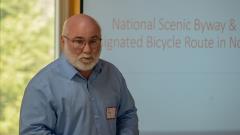Officials emphasize promoting northern Maine’s national scenic byway
- May 13, 2024

FRENCHVILLE, Maine – Three years ago, 134 miles of road stretching across the St. John Valley was designated as a national scenic byway, a distinction that has led to increased tourism and job creation.
Northern Maine Development Commission Senior Planner Jay Kamm emphasized the importance of promoting this byway as a travel destination during a May 8 tourism summit.
National scenic byways have unique features not found elsewhere, and the roads themselves are considered a travel destination. Now, officials are discussing how best to promote this panoramic path along the Canadian border.
And there is a demand to travel these roads. Kamm said that “National scenic byway” is one of the most searched terms across numerous search engines. He said it’s also one of the most common inquiries made to the Maine Office of Tourism.
Kamm spoke to several local community and business leaders at the Frenchville Community Center during the summit, which was hosted by Aroostook County Tourism, a standing committee of the Northern Maine Development Commission focused on improving the region’s economy through tourism marketing.
The 134-mile St. John Valley/Fish River National Scenic Byway is the result of two existing byways combining in 2021. Both byways represent firsts for Maine. The Fish River byway was the state’s first scenic byway and the St. John Valley byway was Maine’s first cultural byway.
The new scenic byway stretches as far west as Dickey on Route 161. From there, it goes east through Allagash and St. Francis until Route 161 transitions to Route 1 into Fort Kent, Madawaska, and all the way to Van Buren and Hamlin. Three different roads south of this road also connect to the byway – Route 11 with Portage Lake, Route 162 at Sinclair, and Route 1 with Cyr Plantation.
The byway was designated for its cultural resources, including its Franco-American, Acadian, and Native American traditions. It was also designated for its logging and forestry and active recreation in the winter and summer.
Kamm told attendants that there are numerous benefits to being located along a byway. He said that, nationwide, there is $16 million worth of funding available via the Federal Highway Administration for National Scenic Byways.
“It’s up to us as a region to really harp on this and make it far more important, both from a tourism standpoint and from a marketing standpoint,” he said.
As it stands, he said more could be done to promote the byway. He said he asked his wife, a Madawaska native, during a trip to the St. John Valley if she could tell him when they reached the byway, but that she was unsure.
“That is kind of a concern to me,” he said. “Someone who was born and raised in that region, who travels from Caribou to Madawaska twice a month, doesn’t know when they’re on the National Byway.”
He said that it is ultimately up to community leaders in the region to decide how this is promoted, but added that gateway signage letting travelers know they’re on the byway would be a good next step.
Last summer, he said Maine DOT came up with a two-foot by three-foot map of the byway, and that he approached businesses from Portage to Allagash and St. Agatha to see if they would display them.
“I don’t want to sound overly enthusiastic, but 100 percent said ‘I will take as many of those as you can get me,’” he said. “I think there’s enthusiasm. We have the ability to do this, we just need to move this forward.”
Filter Press Releases
Contact Information
Ryan Leighton
193 State StreetSHS 25
Augusta ME 04333
207-287-2726
vog.eniam@nothgiel.j.nayr
